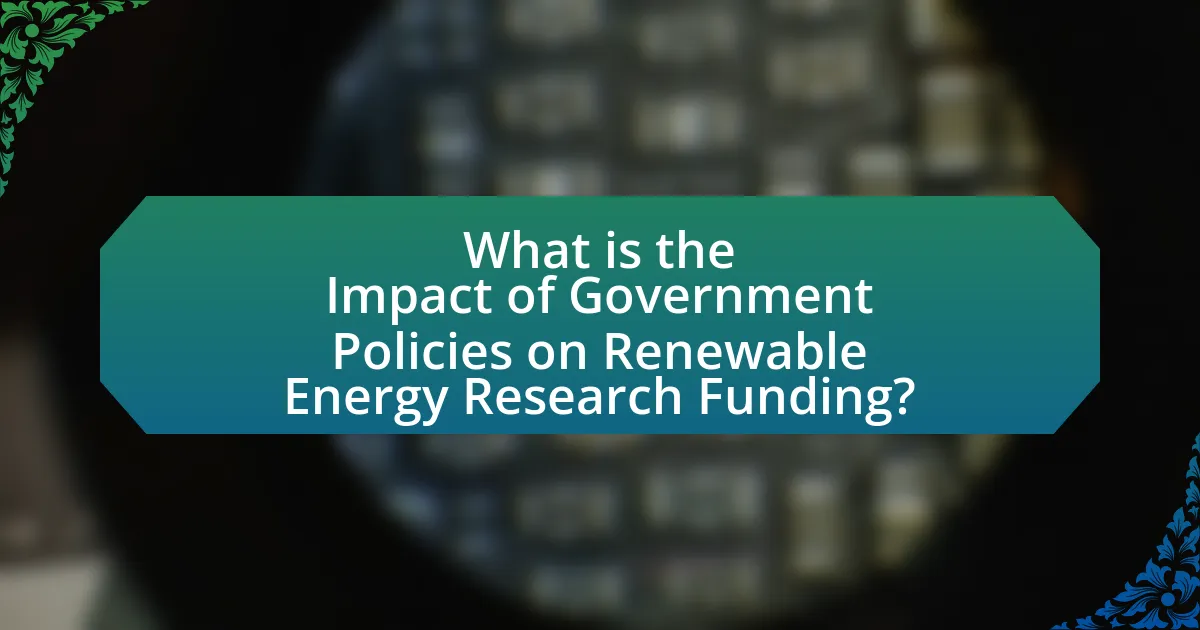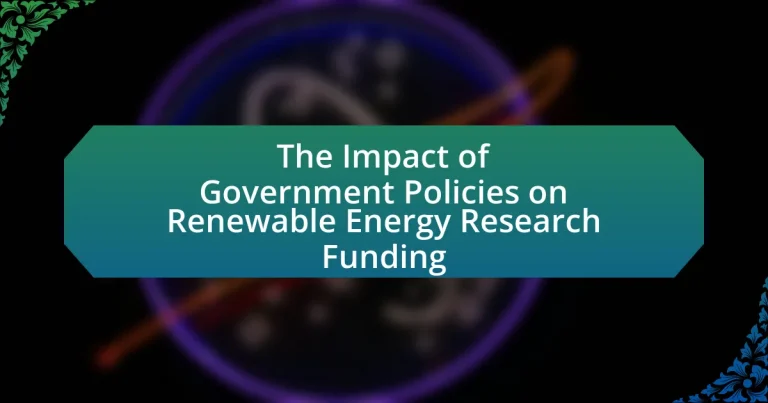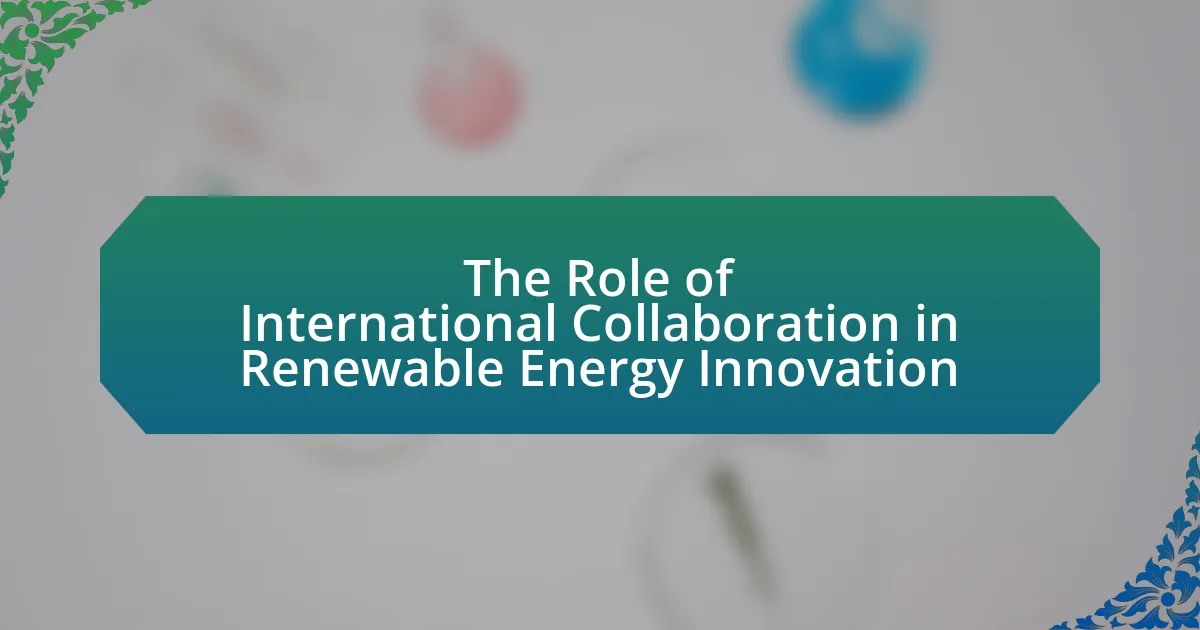The article examines the significant impact of government policies on renewable energy research funding, highlighting how financial incentives, regulatory frameworks, and strategic priorities shape investment landscapes. It discusses the effectiveness of various policies, such as tax credits and public-private partnerships, in promoting innovation and increasing funding levels for renewable technologies. The article also addresses the challenges faced by these policies, including funding limitations and political instability, while emphasizing the importance of stakeholder engagement and international agreements in enhancing funding strategies. Overall, it underscores the critical role of government support in advancing renewable energy research and fostering environmental sustainability.

What is the Impact of Government Policies on Renewable Energy Research Funding?
Government policies significantly influence renewable energy research funding by directing financial resources and establishing regulatory frameworks that promote innovation. For instance, policies such as tax incentives, grants, and subsidies encourage private and public investment in renewable technologies. According to the International Renewable Energy Agency (IRENA), government support accounted for approximately 70% of global renewable energy investment in 2020, highlighting the critical role of policy in shaping funding landscapes. Additionally, countries with clear renewable energy targets and supportive legislation, like Germany and the United States, have seen substantial increases in research funding, leading to advancements in solar and wind technologies.
How do government policies influence renewable energy research funding?
Government policies significantly influence renewable energy research funding by establishing financial incentives, regulatory frameworks, and strategic priorities. For instance, policies such as tax credits, grants, and subsidies directly allocate resources to renewable energy projects, encouraging private and public investment. According to the International Renewable Energy Agency (IRENA), government support accounted for approximately 70% of total renewable energy investment in 2020, highlighting the critical role of policy in shaping funding landscapes. Additionally, regulations that mandate renewable energy targets compel governments to invest in research and development, further driving funding towards innovative technologies.
What types of government policies are most effective in promoting renewable energy research?
Government policies that are most effective in promoting renewable energy research include financial incentives, regulatory support, and public-private partnerships. Financial incentives, such as grants, tax credits, and subsidies, directly lower the cost of research and development, encouraging innovation. For instance, the U.S. federal government has provided over $100 billion in tax incentives for renewable energy projects since 2005, significantly boosting research activities. Regulatory support, including renewable portfolio standards and emissions regulations, creates a market demand for clean energy technologies, prompting increased research efforts. Additionally, public-private partnerships leverage resources and expertise from both sectors, exemplified by initiatives like the U.S. Department of Energy’s SunShot Initiative, which aims to reduce solar energy costs through collaborative research. These policies collectively foster an environment conducive to advancing renewable energy technologies.
How do funding levels change in response to different government policies?
Funding levels for renewable energy research typically increase when government policies prioritize sustainability and clean energy initiatives, such as tax incentives or grants. For instance, the introduction of the Investment Tax Credit (ITC) in the United States significantly boosted solar energy funding, leading to a 167% increase in solar capacity from 2010 to 2019. Conversely, funding levels may decrease when governments roll back support or shift focus to fossil fuels, as seen in various countries that have reduced renewable energy budgets in favor of traditional energy sources. This correlation between government policy and funding is evident in the fluctuating investments observed in renewable energy sectors globally, demonstrating that policy direction directly influences financial support for research and development in this field.
Why is renewable energy research funding important?
Renewable energy research funding is crucial because it drives innovation and development in sustainable energy technologies. This funding enables researchers to explore new methods for harnessing energy from renewable sources, such as solar, wind, and bioenergy, which are essential for reducing greenhouse gas emissions and combating climate change. For instance, a report from the International Renewable Energy Agency (IRENA) indicates that investment in renewable energy research can lead to significant cost reductions in technology deployment, making clean energy more accessible and affordable. Additionally, government policies that support this funding can stimulate economic growth by creating jobs in the renewable energy sector, as evidenced by the U.S. Department of Energy’s findings that every $1 million invested in renewable energy creates approximately 7.5 jobs. Thus, renewable energy research funding is vital for advancing technology, addressing environmental challenges, and fostering economic development.
What are the potential benefits of increased funding for renewable energy research?
Increased funding for renewable energy research can lead to significant advancements in technology, resulting in more efficient energy solutions. Enhanced financial support allows researchers to develop innovative technologies, such as improved solar panels and wind turbines, which can lower the cost of renewable energy production. For instance, the National Renewable Energy Laboratory reported that advancements in solar technology have reduced costs by over 80% since 2010. Additionally, increased funding can stimulate job creation in the renewable energy sector, with the International Renewable Energy Agency estimating that the sector could employ over 24 million people globally by 2030 if adequately supported. Furthermore, such funding can accelerate the transition to a low-carbon economy, helping to mitigate climate change impacts, as evidenced by the Intergovernmental Panel on Climate Change’s findings that rapid deployment of renewable energy is essential for limiting global warming to 1.5 degrees Celsius.
How does renewable energy research contribute to environmental sustainability?
Renewable energy research significantly contributes to environmental sustainability by developing technologies that reduce greenhouse gas emissions and reliance on fossil fuels. This research leads to advancements in solar, wind, and bioenergy systems, which produce clean energy and minimize ecological footprints. For instance, a study by the International Renewable Energy Agency (IRENA) found that doubling the share of renewable energy in the global energy mix could reduce carbon dioxide emissions by up to 70% by 2050. Additionally, renewable energy technologies often require less water than traditional energy sources, further promoting sustainable resource management.
What challenges do government policies face in supporting renewable energy research?
Government policies face several challenges in supporting renewable energy research, primarily including funding limitations, regulatory hurdles, and political instability. Funding limitations arise from competing budget priorities, which often lead to insufficient financial resources allocated for renewable energy initiatives. Regulatory hurdles can impede innovation, as complex approval processes and outdated regulations may slow down research and development efforts. Political instability can disrupt long-term planning and investment in renewable energy, as changes in government can lead to shifts in policy direction and funding commitments. These challenges collectively hinder the effectiveness of government policies in fostering a robust renewable energy research environment.
What are the common barriers to effective policy implementation?
Common barriers to effective policy implementation include lack of stakeholder engagement, insufficient resources, and inadequate communication. Lack of stakeholder engagement often leads to resistance and misunderstanding, as seen in various renewable energy initiatives where local communities were not consulted, resulting in pushback against projects. Insufficient resources, both financial and human, hinder the execution of policies, as evidenced by studies showing that many renewable energy programs fail due to budget constraints. Inadequate communication can create confusion about policy goals and processes, which has been documented in reports highlighting the failure of renewable energy policies to achieve intended outcomes due to unclear messaging.
How do political and economic factors affect renewable energy funding?
Political and economic factors significantly influence renewable energy funding by shaping government policies, investment priorities, and market conditions. For instance, political stability and supportive legislation, such as tax incentives or renewable energy mandates, can attract private investment and increase funding for renewable projects. Conversely, political uncertainty or unfavorable policies can deter investment, leading to reduced funding. Economically, factors like market demand for clean energy, the cost of fossil fuels, and access to capital also play critical roles; for example, a rise in fossil fuel prices can make renewable energy more competitive, thereby increasing funding opportunities. According to the International Renewable Energy Agency, global investment in renewable energy reached $303.5 billion in 2020, highlighting the direct correlation between favorable political and economic conditions and increased funding in the sector.
How can government policies be improved to enhance renewable energy research funding?
Government policies can be improved to enhance renewable energy research funding by increasing direct financial support and creating tax incentives for research initiatives. For instance, countries like Germany have successfully implemented feed-in tariffs that guarantee fixed payments for renewable energy producers, which encourages investment in research and development. Additionally, the U.S. government has utilized the Investment Tax Credit (ITC) and the Production Tax Credit (PTC) to stimulate growth in solar and wind energy sectors, leading to significant advancements in technology and reductions in costs. These policies demonstrate that targeted financial mechanisms can effectively boost funding for renewable energy research, fostering innovation and accelerating the transition to sustainable energy sources.
What best practices can be adopted from successful policies in other regions?
Successful policies in other regions that can be adopted include the implementation of targeted financial incentives, such as tax credits and grants, which have proven effective in stimulating renewable energy research and development. For instance, the United States’ Investment Tax Credit (ITC) has led to a significant increase in solar energy installations, contributing to a 167% growth in solar capacity from 2010 to 2020. Additionally, establishing public-private partnerships, as seen in Germany’s Energiewende initiative, fosters collaboration between government and industry, enhancing innovation and funding efficiency. These practices demonstrate measurable success in increasing renewable energy investments and advancing research initiatives.
How can stakeholder engagement improve policy outcomes for renewable energy funding?
Stakeholder engagement can significantly improve policy outcomes for renewable energy funding by ensuring that diverse perspectives and expertise are incorporated into the decision-making process. Engaging stakeholders, such as industry representatives, community members, and environmental organizations, leads to more informed policies that reflect the needs and priorities of all affected parties. For instance, research by the International Renewable Energy Agency (IRENA) indicates that inclusive stakeholder processes can enhance public acceptance and support for renewable energy initiatives, ultimately resulting in more effective funding allocation and implementation. This collaborative approach not only fosters transparency but also builds trust, which is crucial for the successful deployment of renewable energy projects.
What are the current trends in government policies affecting renewable energy research funding?
Current trends in government policies affecting renewable energy research funding include increased investment in clean energy technologies, a focus on decarbonization goals, and the implementation of tax incentives for research and development. Governments worldwide are allocating more resources to support innovation in renewable energy, with the U.S. government proposing to invest $35 billion in clean energy research as part of its climate agenda. Additionally, policies such as the Inflation Reduction Act in the U.S. provide tax credits for renewable energy projects, encouraging private sector investment and accelerating research initiatives. These trends reflect a global shift towards sustainable energy solutions and a commitment to meeting international climate targets.
How are international agreements influencing national funding strategies?
International agreements are significantly influencing national funding strategies by establishing frameworks that prioritize renewable energy investments. For instance, commitments made under the Paris Agreement compel countries to allocate resources towards reducing greenhouse gas emissions, which often translates into increased funding for renewable energy projects. According to the International Renewable Energy Agency (IRENA), countries that ratified the Paris Agreement have reported a 20% increase in public funding for renewable energy initiatives since its adoption in 2015. This trend demonstrates how international commitments can drive national policies and funding allocations towards sustainable energy solutions.
What role do public-private partnerships play in renewable energy research funding?
Public-private partnerships (PPPs) play a crucial role in renewable energy research funding by leveraging resources, expertise, and risk-sharing between government entities and private companies. These collaborations enhance innovation and accelerate the development of renewable technologies, as evidenced by initiatives like the U.S. Department of Energy’s SunShot Initiative, which aims to reduce solar energy costs through partnerships with private firms. In 2020, the International Renewable Energy Agency reported that such partnerships have led to increased investment in research and development, resulting in significant advancements in efficiency and cost-effectiveness of renewable energy solutions.
What practical steps can be taken to advocate for better government policies in renewable energy research funding?
To advocate for better government policies in renewable energy research funding, stakeholders can engage in targeted lobbying efforts to influence policymakers. This involves organizing campaigns that highlight the economic and environmental benefits of renewable energy, such as job creation and reduced greenhouse gas emissions. For instance, a report from the International Renewable Energy Agency indicates that transitioning to renewable energy could create 24 million jobs globally by 2030. Additionally, stakeholders can form coalitions with industry leaders, researchers, and advocacy groups to present a united front, thereby amplifying their message and increasing visibility. Utilizing data-driven arguments and case studies demonstrating successful renewable energy initiatives can further strengthen advocacy efforts. Engaging the public through awareness campaigns can also mobilize grassroots support, pressuring government officials to prioritize renewable energy funding in their agendas.




